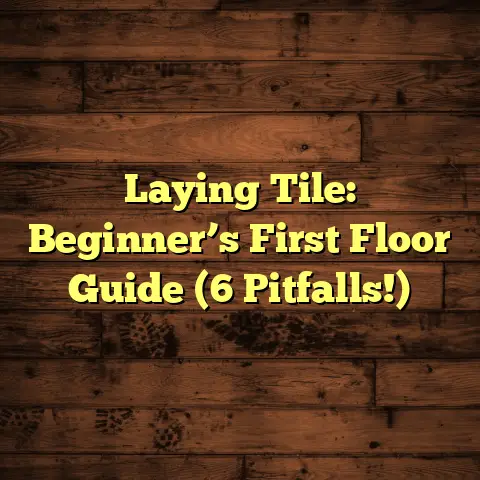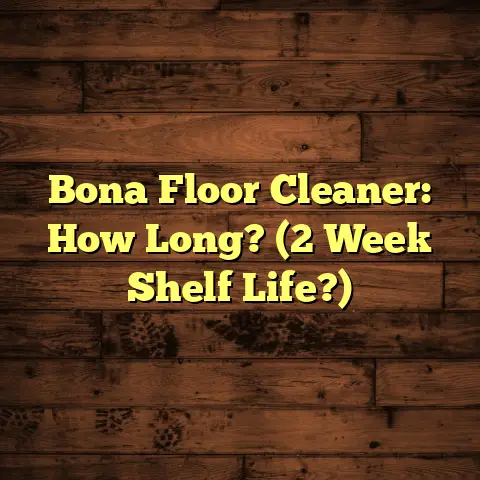Dog Pee on Laminate: Quick Clean Up! (3 Fixes)
Quick Clean Up! (3 Fixes)
I’m Mike, a flooring contractor with over 15 years of experience.
I’ve seen it all, from water damage to scratches, and yes, even a fair share of pet accidents.
Today, I want to talk about something near and dear to many of us: our furry friends and our laminate floors.
We all love our dogs, right?
They bring joy, companionship, and unconditional love into our lives.
But let’s be honest, they also bring the occasional “oops” moment, especially when it comes to accidents on our floors.
And if you’re like many of my clients, you’ve probably chosen laminate flooring for its durability, affordability, and aesthetic appeal.
It’s a fantastic option, but dog pee?
That’s a different story.
It can be a real pain if not handled quickly and correctly.
Think of “smart living” – it’s not just about having the latest gadgets.
It’s about creating a home that’s functional, beautiful, and easy to maintain, even with pets.
Balancing pet ownership with a clean and damage-free home is totally achievable.
This guide will walk you through proven methods to tackle those inevitable accidents.
I will show you how to clean dog urine from laminate flooring quickly and effectively.
I’ll share my top three fixes to keep your floors looking great and your home smelling fresh.
Let’s dive in!
Understanding Laminate Flooring and
Its Vulnerabilities
So, what exactly is laminate flooring?
Well, in a nutshell, it’s a multi-layer synthetic flooring product fused together through a lamination process.
Typically, it consists of a high-density fiberboard (HDF) core, a decorative layer that gives it the wood-like appearance, and a protective top layer.
This top layer is usually a clear, durable coating that resists scratches, stains, and fading.
It’s this construction that makes laminate such a popular choice for modern homes.
Benefits of Laminate Flooring:
- Durability: Resistant to scratches, impacts, and wear.
- Affordability: Generally less expensive than hardwood.
- Ease of Installation: Often features a click-lock system for easy DIY installation.
- Low Maintenance: Easy to clean and requires no special treatments.
- Aesthetic Appeal: Available in various styles that mimic wood, stone, and tile.
Many pet owners gravitate towards laminate because of its scratch resistance and ease of cleaning.
Compared to hardwood, it’s less likely to show scratches from dog claws, and wiping up spills is usually a breeze.
However, don’t let that fool you into thinking it’s indestructible!
The Vulnerabilities:
Laminate flooring has a few Achilles heels, and moisture is definitely one of them.
Unlike solid wood, laminate is susceptible to water damage.
The HDF core can swell and warp when exposed to moisture for extended periods.
Dog urine, unfortunately, falls into this category.
When urine seeps into the seams between planks or penetrates the surface, it can cause some serious problems:
- Warping: The edges of the planks can lift and become uneven.
- Staining: Urine can leave unsightly stains, especially on lighter-colored laminates.
- Odor Retention: The porous core can absorb odors, making your home smell like a kennel.
I’ve seen firsthand the damage that untreated dog urine can cause.
I remember one client who waited too long to clean up a few accidents, and the floor ended up with permanent stains and a lingering odor that was nearly impossible to get rid of.
Trust me, you don’t want that!
Cleaning Agents:
Another thing to keep in mind is how laminate reacts to different types of cleaning agents.
While laminate is generally easy to clean, using the wrong products can cause damage.
Avoid using abrasive cleaners, as they can scratch the surface.
Also, be cautious with harsh chemicals like bleach or ammonia, as they can discolor the laminate or damage the protective coating.
Always opt for pH-neutral cleaners specifically designed for laminate flooring.
These are gentle enough to clean without causing harm.
Key Takeaway:
Laminate flooring is a great choice for pet owners, but it’s essential to understand its vulnerabilities.
Moisture is the enemy, and using the right cleaning products is crucial.
By taking these precautions, you can keep your laminate floors looking great for years to come.
The Importance of Quick Action
Let’s get one thing straight: when it comes to dog urine on laminate flooring, time is of the essence!
I can’t stress this enough.
The faster you act, the better your chances of preventing long-term damage.
Why is immediate clean-up so crucial?
Well, as I mentioned earlier, laminate is susceptible to moisture damage.
The longer urine sits on the floor, the more likely it is to seep into the seams and penetrate the HDF core.
This can lead to warping, staining, and odor retention – all things you definitely want to avoid.
Consequences of Leaving Urine Untreated:
- Lingering Odors: Urine contains ammonia and other compounds that can create a persistent, unpleasant smell.
- Bacteria Growth: Urine provides a breeding ground for bacteria, which can lead to unsanitary conditions and potential health risks.
- Irreversible Floor Damage: Prolonged exposure to urine can cause permanent stains and warping, requiring costly repairs or even replacement of the flooring.
Here’s a statistic that might surprise you:
According to a survey by the American Pet Products Association (APPA), about 67% of U.S. households own a pet.
That’s a lot of potential for accidents!
As a pet owner, being prepared is key.
Keep cleaning supplies readily available and make it a habit to check your floors regularly for any signs of accidents.
Psychological Aspect:
Beyond the physical damage, maintaining a clean environment has a significant impact on our psychological well-being.
A clean home is a happy home.
I’ve found this to be true in my own life and in the experiences of many of my clients.
A clean and fresh-smelling home reduces stress, promotes relaxation, and creates a more pleasant living space for both you and your pets.
When your home smells like dog urine, it can create a sense of unease and anxiety.
It’s not just about the aesthetics; it’s about creating a healthy and comfortable environment for everyone.
Anecdote Time!
I once worked with a client who was constantly stressed about her dog having accidents on her laminate floors.
She was always on edge, worried about the potential damage and the lingering odors.
After implementing a quick clean-up routine and using the right cleaning products, she noticed a significant improvement in her overall mood.
She felt more relaxed and in control, and her home felt cleaner and more inviting.
Key Takeaway:
Don’t underestimate the importance of quick action when it comes to dog urine on laminate flooring.
The faster you clean it up, the better your chances of preventing long-term damage and maintaining a clean and healthy home.
Be prepared, stay vigilant, and remember that a clean home is a happy home for both you and your furry friends.
Quick Clean-Up Fix #1:
Using Household Ingredients
Alright, let’s get down to business!
The first quick clean-up method I want to share involves using common household ingredients.
This is a great option if you’re looking for a natural, cost-effective solution.
The star players in this method are white vinegar, baking soda, and water.
These ingredients are readily available, safe to use, and surprisingly effective at neutralizing odors and breaking down urine.
Step-by-Step Guide:
- Blot Up Excess Urine: As soon as you spot the accident, grab a clean cloth or paper towel and blot up as much urine as possible. Avoid rubbing, as this can spread the urine and push it deeper into the floor.
- Prepare the Solution: In a spray bottle, mix equal parts white vinegar and water. For example, you can use 1/2 cup of white vinegar and 1/2 cup of water.
- Spray the Affected Area: Liberally spray the vinegar solution onto the affected area, making sure to cover the entire stain.
- Let It Sit: Allow the solution to sit for 5-10 minutes. This gives the vinegar time to neutralize the odors and break down the urine.
- Blot Again: Use a clean cloth or paper towel to blot up the vinegar solution. Again, avoid rubbing.
- Apply Baking Soda: Sprinkle a generous amount of baking soda onto the affected area. Baking soda is a natural odor absorber and will help to draw out any remaining moisture and odors.
- Let It Dry: Allow the baking soda to sit for several hours, or even overnight, until it is completely dry.
- Vacuum Up Baking Soda: Once the baking soda is dry, vacuum it up using a hose attachment or a vacuum with a brush.
- Wipe Clean: Finally, wipe the area with a damp cloth to remove any remaining residue. Make sure the cloth is only slightly damp, as you don’t want to saturate the floor with water.
- Dry Thoroughly: Use a clean, dry cloth to thoroughly dry the area. You can also use a fan to speed up the drying process.
Effectiveness:
This method works by neutralizing the ammonia in the urine with the acidity of the vinegar.
The baking soda then absorbs any remaining odors and moisture.
It’s a simple yet effective way to tackle minor accidents and keep your laminate floors smelling fresh.
Tips for Thorough Drying:
- Use a Fan: Place a fan near the cleaned area to promote air circulation and speed up drying.
- Open Windows: If the weather permits, open windows to increase ventilation.
- Use a Dehumidifier: If you live in a humid climate, use a dehumidifier to remove excess moisture from the air.
Environmental Benefits:
One of the great things about this method is that it’s environmentally friendly.
White vinegar and baking soda are natural, non-toxic ingredients that won’t harm your pets or the environment.
Plus, you’re avoiding the use of harsh chemicals that can pollute the air and water.
My Personal Experience:
I’ve used this method countless times, both in my own home and in the homes of my clients.
It’s particularly effective for fresh accidents that haven’t had time to soak into the floor.
For older, more stubborn stains, you may need to repeat the process or try one of the other methods I’ll be sharing.
Key Takeaway:
Using household ingredients like white vinegar and baking soda is a simple, natural, and effective way to clean up dog urine on laminate flooring.
It’s a great first line of defense against accidents and a safe option for homes with pets and children.
Quick Clean-Up Fix #2:
Commercial Cleaning Products
If the household ingredient method isn’t quite cutting it, or if you’re dealing with a particularly stubborn stain or odor, it might be time to bring in the big guns: commercial cleaning products.
Specifically, I’m talking about enzymatic cleaners designed for pet urine.
These products work at a molecular level to eliminate odors and stains, making them highly effective for laminate flooring.
How Enzymatic Cleaners Work:
Enzymatic cleaners contain enzymes that break down the organic compounds in urine, such as ammonia, uric acid, and other proteins.
These enzymes essentially “eat” the urine, eliminating the source of the odor and stain.
Unlike regular cleaners that simply mask the odor, enzymatic cleaners get rid of it completely.
Choosing the Right Product:
When selecting an enzymatic cleaner, there are a few things to keep in mind:
- Read the Label: Look for products that specifically mention “enzymatic” or “biological” cleaning action. Also, check to make sure the product is safe for use on laminate flooring.
- Check the Ingredients: Avoid products that contain harsh chemicals, such as bleach or ammonia. These can damage laminate and are not necessary for effective cleaning.
- Consider the Scent: Some enzymatic cleaners have a strong scent, while others are unscented. Choose a scent that you find pleasant or opt for an unscented option if you’re sensitive to smells.
- Read Reviews: Check online reviews to see what other pet owners have to say about the product. This can give you a good idea of its effectiveness and any potential drawbacks.
Potential Brands to Consider:
- Nature’s Miracle: A well-known brand that offers a variety of enzymatic cleaners for pet messes.
- Rocco & Roxie Stain & Odor Eliminator: A popular choice among pet owners for its effectiveness and pleasant scent.
- Simple Solution: Another reputable brand that offers a range of enzymatic cleaners for different types of pet stains and odors.
Step-by-Step Application Process:
- Blot Up Excess Urine: As with the household ingredient method, start by blotting up as much urine as possible with a clean cloth or paper towel.
- Apply the Enzymatic Cleaner: Follow the instructions on the product label to apply the cleaner to the affected area. Typically, you’ll need to spray or pour the cleaner onto the stain, making sure to saturate it completely.
- Let It Sit: Allow the cleaner to sit for the recommended amount of time, usually 10-15 minutes. This gives the enzymes time to break down the urine.
- Blot Again: Use a clean cloth or paper towel to blot up the cleaner. Avoid rubbing, as this can spread the urine and the cleaner.
- Dry Thoroughly: Use a clean, dry cloth to thoroughly dry the area. You can also use a fan to speed up the drying process.
User Reviews and Testimonials:
I’ve heard countless success stories from clients who have used enzymatic cleaners to tackle tough pet stains and odors.
One client told me that she had tried everything to get rid of the lingering smell of dog urine in her living room, but nothing seemed to work.
Finally, she tried an enzymatic cleaner and was amazed at how effectively it eliminated the odor.
She said that her living room finally smelled fresh and clean again.
Key Takeaway:
Commercial enzymatic cleaners are a powerful tool for dealing with dog urine on laminate flooring.
They work at a molecular level to eliminate odors and stains, and they’re safe to use on laminate when used according to the product label.
If you’re struggling with stubborn stains or odors, I highly recommend giving them a try.
Quick Clean-Up Fix #3: Steam Cleaning
Okay, let’s talk about steam cleaning!
This is the third quick clean-up fix I want to share, and it’s a great option for deep cleaning laminate flooring, especially after a dog urine accident.
Steam cleaning uses hot steam to sanitize and remove stains from surfaces.
It’s a chemical-free way to clean your floors and can be particularly effective at tackling lingering odors and bacteria.
How Steam Cleaning Works:
Steam cleaners heat water to a high temperature, creating steam that is then released onto the floor through a cleaning head.
The hot steam loosens dirt, grime, and stains, while also killing bacteria and other microorganisms.
The moisture is then sucked back up by the steam cleaner, leaving your floors clean and sanitized.
Benefits of Steam Cleaning:
- Sanitization: Steam cleaning kills bacteria, viruses, and other microorganisms, making it a great option for homes with pets and children.
- Stain Removal: The hot steam can loosen and remove stubborn stains, including those caused by dog urine.
- Odor Elimination: Steam cleaning can help to eliminate lingering odors by killing the bacteria that cause them.
- Chemical-Free Cleaning: Steam cleaning uses only water, so it’s a safe and environmentally friendly way to clean your floors.
Using a Steam Cleaner on Laminate Flooring:
While steam cleaning can be effective, it’s important to take precautions to avoid damaging your laminate floors.
Here’s a detailed guide on how to use a steam cleaner safely and effectively:
- Check the Manufacturer’s Instructions: Before using a steam cleaner on your laminate floors, check the manufacturer’s instructions to make sure it’s safe to do so. Some laminate flooring manufacturers recommend against steam cleaning, as it can cause moisture damage.
- Vacuum First: Before steam cleaning, thoroughly vacuum your floors to remove any loose dirt, debris, and pet hair.
- Use a Laminate-Safe Steam Cleaner: Make sure your steam cleaner is specifically designed for use on laminate flooring. These steam cleaners typically have adjustable steam settings and a microfiber cleaning pad.
- Use the Lowest Steam Setting: When steam cleaning laminate, use the lowest steam setting possible. You want to avoid saturating the floor with too much moisture.
- Move Quickly: Keep the steam cleaner moving at a steady pace and avoid holding it in one spot for too long. This will prevent moisture from seeping into the seams of the laminate.
- Dry Thoroughly: After steam cleaning, use a clean, dry cloth to thoroughly dry the floors. You can also use a fan to speed up the drying process.
When to Opt for Steam Cleaning:
Steam cleaning is a good option for deep cleaning laminate floors after a dog urine accident, especially if you’re dealing with lingering odors or stains.
It’s also a good choice if you want to sanitize your floors without using harsh chemicals.
However, it’s important to use caution and follow the manufacturer’s instructions to avoid damaging your laminate.
Maintaining Laminate Flooring Post-Cleaning:
After steam cleaning, there are a few things you can do to keep your laminate floors looking great:
- Use a Laminate Floor Cleaner: Regularly clean your floors with a pH-neutral cleaner specifically designed for laminate flooring.
- Avoid Excessive Moisture: When cleaning, use a damp mop or cloth and avoid saturating the floor with water.
- Use Floor Mats: Place floor mats at entrances to trap dirt and moisture and prevent them from being tracked onto your laminate floors.
- Trim Your Pet’s Nails: Keep your pet’s nails trimmed to prevent them from scratching your laminate floors.
Key Takeaway:
Steam cleaning can be a viable option for deep cleaning laminate flooring after a dog urine accident, but it’s important to use caution and follow the manufacturer’s instructions.
By taking the necessary precautions and maintaining your floors properly, you can keep them looking great for years to come.
Conclusion
So, there you have it!
Three quick and effective clean-up solutions for dog urine on laminate flooring.
We’ve covered everything from using household ingredients like white vinegar and baking soda to commercial enzymatic cleaners and steam cleaning.
Remember, the key to success is quick action.
The faster you clean up the accident, the better your chances of preventing long-term damage and maintaining a clean and hygienic living space.
By being proactive and implementing these fixes, you can embrace the joys of pet ownership while managing the challenges that come with it.
As I mentioned at the beginning of this article, smart living is all about balancing technology, cleanliness, and pet ownership seamlessly.
It’s about creating a home that’s functional, beautiful, and easy to maintain, even with our furry friends.
I hope this guide has been helpful and that you feel more confident in your ability to tackle dog urine accidents on your laminate flooring.
Remember, a clean home is a happy home for both you and your pets!





